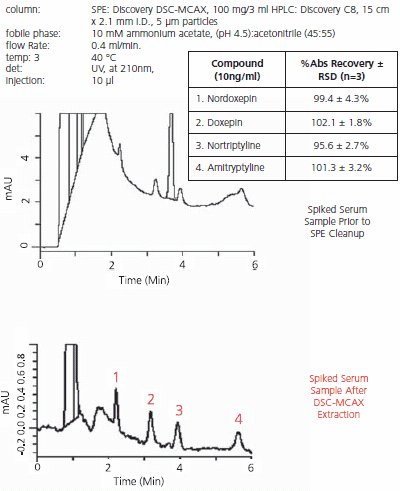Mixed-Mode SPE Improves Extraction of Pharmaceutical Compounds from Biological Fluids
David Bell, An Trinh, Carmen Santasania, Yuhui Yang, Michael Ye
Reporter EU Volume 18
In an ideal SPE (solid phase extraction) scenario, under a single eluant system the analytes of interest are bound strongly but reversibly to the particle while impurities and other unwanted sample components pass through unretained. Unfortunately, this scenario is rarely realized using a single SPE tube. Typically, conditions strong enough to remove impurities also remove at least some of the analyte, reducing the overall recovery of the method. One way around this situation, a way that permits both enhanced analyte retention and reduced matrix impurity contamination, is by using mixed-mode SPE phases that take advantage of the differences between the retention mechanisms of analytes and unwanted components of the sample.
Using ion-exchange and reversed-phase SPE phases conjointly and manipulating the pH and organic modifier concentration of the eluant can isolate basic compounds from neutral and acidic components of the sample. Analytes with the appropriate charge interact with the ion-exchange bonded phase, locking them during the extraction process. With analyte molecules safely locked, the SPE tube can be washed with strong solvents to thoroughly remove impurities. Then, the pH of the eluant can be adjusted to reduce the charge on the analyte molecules and release them from the ion-exchange groups of the bonded phase. Since in the mixed-mode SPE system the compounds are also retained by a reversed-phase mechanism, the eluant’s organic component percentage can also be adjusted to achieve selective elution.
Mixed-mode SPE of basic pharmaceutical compounds
In the study reported here, basic pharmaceutical compounds and metabolites were extracted from biological fluids using Discovery DSC-MCAX, which comprises both C8 and SCX (benzenesulphonic acid) functional groups followed by analysis on a Discovery C18 HPLC column with UV detection. The method yielded recoveries greater than 90% across all compounds tested and relative standard deviations consistently less than 5%. We developed two different extraction protocols that targeted different analyte charge or polarity.
Generic Extraction Protocol 1: Non-polar basic compoundsReferences
Protocol 1 is suitable for basic compounds that are ionized at pH 6.
- Dilute 1 mL of sample (urine, plasma, serum) with 1 mL of 50 mM ammonium acetate (pH 6).
- Condition a 100 mg/3 mL DSC-MCAX SPE tube with 1 mL methanol.
- Equilibrate the SPE tube with 1 mL 50 mM ammonium acetate (pH 6).
- Load diluted urine (or plasma) sample on the SPE tube at a flow rate of 1 mL/min.
- Elute unwanted sample components with 1 mL each of the following sequence of solvents: 50 mM ammonium acetate (pH 6), 1M acetic acid, methanol.
- Elute analytes with 5% ammonium hydroxide in methanol.
Generic Extraction Protocol 2: Weakly basic and polar basic compounds
Protocol 2 is suitable for compounds not retained (not ionized) at pH 6, acidic compounds, or where the analyte has a pKa of ~ 6. Protocol 2 is the same as Protocol 1, except 10 mM potassium phosphate (pH 3) or 10 mM acetic acid buffer (pH 3) is used in place of the pH 6 buffer. Also, the 1M acetic acid is not needed in step 5.
Examples of mixed-mode SPE for basic pharmaceutical compounds in serum
Following Generic Extraction Protocol 1, mixed-mode SPE on Discovery DSC-MCAX SPE tubes was used to extract trace levels (10 ng/ mL) of TCAs from serum. In Figure 1, pre-SPE and post-SPE samples analyzed by HPLC-UV are compared. Note that a near baseline level clean-up was achieved and average recovery values were greater than 95% with less than 5% RSD.

Figure 1.Extraction of 10 ng/mL Tricyclic Antidepressants from Serum. Generic Extraction Protocol 1
Employing Generic Extraction Protocol 2, high recoveries and excellent reproducibility were obtained for all of the compounds listed in Table 1. This emphasizes the versatility and suitability of the DSC-MCAX for drug screening in biological fluids.
Conclusion
Mixed-mode SPE methods rely on two or more retention mechanisms to simultaneously extract a broad range of compounds from a single biological sample. Slight changes in eluant conditions bring about selective elution and high, reproducible recovery of trace levels of analytes free of contamination from the sample matrix. Discovery mixed-mode SPE phases, like the DSC-MCAX described here, put the perfect SPE scenario within reach.
如要继续阅读,请登录或创建帐户。
暂无帐户?